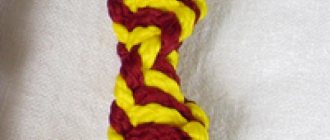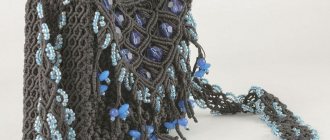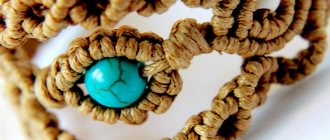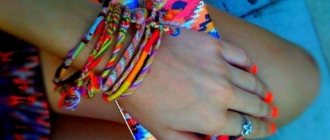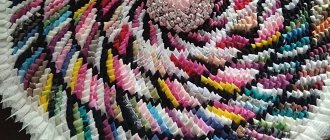Nowadays, this type of needlework as macrame has become a fashionable hobby. Craftsmen create wall panels, lace, figurines of animals, birds and plants, keychains, flower pots, and elegant jewelry. Beads, rhinestones, and sparkles can be woven into products. The crafts are very beautiful, pleasant to the touch, and sometimes useful around the house.
Learning the art of macrame is not difficult for beginning needlewomen. You need to learn how to weave all the main knots and work according to the patterns.
What is macrame
Macrame is the art of weaving knots. It goes back to the ancient art of weaving these elements from threads. In ancient times, some peoples (Slavs; Incas and other Indians of North, Central and South America; inhabitants of Ancient Babylon, Israel and Ancient China) communicated using knotted writing. They tied knots of different shapes on different colored cords.
Macrame came to Europe from the East in the 8th-9th centuries. In the Middle Ages, this type of art was one of the main ones - lace was woven using macrame.
Sailors made a significant contribution to the improvement of technology. Using knots, they tied and secured cables and rescued those who had fallen overboard. In their spare time, sailors wove jewelry and small household items from ropes. Sea knots are very strong: they are quickly woven and easily unraveled.
In the 17th century, macrame came to North America. From the beginning of the 20th century to this day, this type of needlework has found its admirers.
Advantages of technology
Macrame has many exceptional, undeniable advantages that are superior to other types of handcraft. This is a simple and straightforward craft. If errors occur, you can easily make edits. High-quality products are very durable and give joy for many years.
Using the macrame technique we weave:
- hammocks;
- toys;
- flowerpot;
- panel on the wall;
- reticule.
With nuts
You can weave baubles from threads and decorate them with the most unexpected materials. For example, nuts.
Baubles made of threads and nuts
The technology for making such a bracelet is identical to the inclusion of Shambhala beads in a bracelet tied with square knots , or a braided braid with beads. Only in this option, instead of threads, you will need a rope.
Weaving features
The hands of craftswomen create amazing examples of products using the macrame technique. The experience gained and constant improvement of skills will help you become a true master.
What you need for work
Initially, you need to equip a place for classes.
You will need the following tools:
- multi-colored threads;
- scissors;
- thick and thin hooks;
- board covered with cotton wool;
- pins;
- needles with a large eye;
- ruler or measuring tape;
- clamps (vises);
- glue;
- weights;
- lighter or matches;
- metal rings.
Macrame threads
Macrame is woven from different threads. The main requirement for them is a smooth, rounded cut and good curl. When woven, they form a clear and beautiful pattern.
Threads from 0.8 mm to 5 mm in thickness are ideal. The thinner the thread, the smaller the product will be.
Light or pastel shades of thread look great. You can decorate the craft with beads, beads, balls, sticks, wooden rings, or weave it on a wire frame.
Suitable threads from any material:
- Waxed - thin cotton or synthetic thread impregnated with wax, up to 2 mm thick. Ideal for weaving jewelry. It can be threaded into beads and weaved into small details and crafts. For needlework, thread with a thickness of 0.8 mm and 1 mm is used. This material is short-lived, so products quickly lose their original appearance.
- Cotton - thread 1-5 mm thick.
- Soutache is a flat finishing cord intended for sewing and weaving.
- Jute - it is woven from the jute plant. Thickness - from 1 mm to 4 mm. Both large and small things are woven from it. This rough material must be boiled and handled with gloves.
- Sisal - strands of hard plant material. They are used to weave hammocks and scratching posts for cats.
- Silk - it needs to be lubricated with glue so that it does not slip. While working, you should constantly moisten your fingers in water and tie the knots very tightly.
- Floss is ideal for creating jewelry and small crafts.
- Cotton knitting yarn is a fine yarn that needs to be folded in half, so you need to be careful how the knots lie evenly. Suitable threads for macrame are Iris, Chamomile, Lotus, Camellia, Rose. Small items are woven from cotton yarn: jewelry, pendants, bracelets.
- Linen cord is about 3 mm thick, which is ideal for bulky work.
- Wool yarn - twisted threads fit well into knots for soft items.
- Polypropylene laundry cord is a rope with a thickness of 1.5 mm, from which panels and bags are woven. White cords are most common, but other colors can be found.
- Polypropylene twine is a rigid twisted cord. While working, you need to protect your hands with gloves from calluses and periodically wet your hands with water.
- Polypropylene yarn - similar in properties to twine, but a little thinner.
- Lurex is a glossy synthetic thread that needs to be tied very tightly.
- Fishing thread is a slippery thread 0.7-1.5 mm thick, from which bracelets, belts, and jewelry are woven. It is not easy to tie knots with it.
- Nylon is a thin synthetic material for tiny crafts. It is fusible, so the threads retain their original shape.
- Macrame yarn is a synthetic yarn about 1.5 mm thick, soft and pleasant to the touch.
Schemes for beginners
Weaving patterns are very visual and practical. They help inexperienced beginners take their first steps. Many macrame masters draw sketches themselves.
Fenechka
In Indian culture, the “friendship bracelet” was considered a very important gift: people became called brothers and sisters. Many centuries later, woven thread baubles became popular thanks to hippies.
Diamond shaped napkin
A patterned scarf with an ornament or a table napkin will be an excellent surprise for a Birthday or New Year.
.
Macrame knots in baubles
Thread baubles are woven using not only the already listed macrame knots. The use of additional techniques from one of the oldest types of needlework allows fenco weavers to create airy and unusually beautiful decorations. For example, using air loops combined with tatting knots, you can create an openwork bracelet from threads.
Figure No. 4. Combination of air loops and tatting knots.
Weaving:
- Cut 2 threads of 50 cm and 2 threads of 1 m.
- Attach to the base.
- Knit the left-hand tatting on the left thread.
- Repeat with the right thread using the right-hand technique.
- At an equal distance from the warp threads, use pins to secure loops of the same size on each side.
- Knit the left-hand tatting, securing the air loop.
- Repeat on the right side on the right thread.
- Remove the pins and transfer to form air loops in the next row.
- Continue weaving, alternating sides until the end of the bracelet.
Macrame weaving ideas
With the help of macrame you can weave any product that demonstrates beauty and elegance. These can be flowers, lace, handbags and much more.
Master classes on making various things
Among the master classes on macrame for beginners, it is not difficult to find patterns for weaving flowerpots, various decorations and products for the interior.
Panel on the wall
A wicker panel will replace curtains, curtains or a carpet and will give the interior of the apartment a touch of originality.
Lesson:
- Prepare 10 cords 5 m long and a wooden plank 50 cm long. Fold each cord in half and fasten it to the plank using the front fastening method with a lock. Leave a distance of 7–8 cm between the threads.
- Weave a double flat knot from the first pair of cords. Repeat on the remaining pairs.
- Separate two cords close to the center from the 1st knot. From the 2nd, separate the two outer cords. Weave them into a double flat knot. Repeat on all pairs of cords.
- Repeat the steps on the remaining cords until the end of the work.
Belt
A few simple techniques will help you weave a belt, watch strap, collar and leash for your dog. To make a belt, you will need strong cords made of silk or synthetics and a belt buckle on which loops are woven.
Lesson:
- Prepare three cords 10 m long. Secure them to the buckle using the front fastening method with a lock.
- Make a long row of double flat knots.
- At the end, secure the cords with a diagonal bead roller.
Flowerpots
Flower pots will replace a regular pot, add beauty to the interior decoration and create coziness in the house. You should choose only very strong, rigid threads.
The knots will be woven around the metal ring. The finished flowerpot is hung not by a loop, but by a steel hook.
Lesson:
- Prepare eight threads 6 m long and fasten the front with a lock.
- Divide them into parts, each of which will have four threads.
- From the first four threads, weave a series of left-handed flat knots to form a column 50 cm long.
- Repeat on the remaining parts. You will get four “handles”.
- Under all of them, weave a row of two square knots (then in the work you need to do exactly these).
- Separate the third and fourth threads on the left from the first column. From the second - the first and second. From the point of their connection, measure 8 cm down on each thread. Tie them into one column of three knots.
- Take the 3rd and 4th threads from the second column, as well as the 1st and 2nd from the third. Tie a row of three knots.
- Draw the 3rd and 4th threads from the third column, as well as the 1st and 2nd from the fourth. Tie a row of three knots.
- Select the 3rd and 4th threads from the fourth column, the 1st and 2nd from the first. Tie a row of three knots.
- Separate the 3rd and 4th threads from the first column, the 1st and 2nd from the second. Measure 6 cm down and weave three more knots.
- Take the 3rd and 4th threads from the second column, the 1st and 2nd from the third. Measure 6 cm down and weave three more knots.
- Draw the 3rd and 4th threads from the third column, the 1st and 2nd from the fourth. Measure 6 cm down and make four knots.
- Select the 3rd and 4th threads from the fourth column, the 1st and 2nd from the first. Measure 6 cm down and weave three knots. The product must connect.
- Place a flower pot in a flowerpot to test its strength. Pull all threads tightly.
- Make a final braid that will secure the plant pot. Fold a thread 50 cm long in half and wrap it around the braid. Tighten the loops tightly.
Owl
As a child, many people in their home had a panel, toy or pendant in the shape of an owl, woven using the macrame technique. The owl is a symbol of wisdom. It is believed that it brings good luck and prosperity to the house. You can weave a figurine of a night predator with your own hands.
The owl's beak is made from cardboard by cutting out a piece in the shape of a triangle and painting it dark. For the eyes you will need two cardboard circles or large beads.
Lesson:
- Cut six threads 25 cm long and 12 threads 150 cm long.
- Make a bundle of six short threads. Fold the long threads in half and throw them through the bun.
- Divide the long threads into several groups, four threads each. In the first row, weave six square knots (hereinafter referred to as the same knots).
- In the second row, separate the first two and last two threads. Tie five knots from the remainder.
- Repeat the same in the third row and weave four knots.
- The same thing - in the fourth row, then make three knots.
- The same - in the fifth row, weave two knots.
- Repeat in the sixth row and weave one knot lying in the center.
- From the left, take four threads and tighten six knots. Repeat on the right.
- Spread the two central threads to the sides. On the left side, weave a diagonal bridle from rep knots. It should start at the center and end at the last node in the column. Repeat the same on the right thread.
- Weave four more diagonal bridges (from the center to the edges) on both sides.
- Weave one knot from the four threads located in the middle.
- In the next row, make two knots from the eight central threads.
- The third row requires three knots, the fourth requires four, and the fifth requires five.
- Divide the threads in the sixth row equally into two groups and weave three rows of knots into them. Each further row includes one less node than the previous one. Leave a little fringe.
Keychain
Using this original hand-made dragonfly keychain, you can decorate a bunch of keys.
Lesson:
- String beads for the eyes onto a cord folded in half.
- Pass the right end under the middle and out over the left.
- Pass the left end of the lace over the center and tighten it. The beads should not move.
- Place the left end under the center and bring it above the right.
- Repeat these steps in the work a little lower and secure. You will get the first pair of dragonfly wings.
- Repeat all steps 2-5 and make the second pair of wings.
- Weave loops to the end and fasten.
Children's bracelet
You can weave bracelets using the macrame technique. Even a five year old can do this.
Lesson:
- Place two 1 m long laces together and bend them in half.
- Measure a distance from the edge equal to the circumference of your wrist and add another 10 cm. Make a loop.
- You need to use a crossbar for tying. Place the load-bearing ends of the laces in the middle, and the working ends on the sides.
- Throw the working ends over the main ones.
- Place the left side of the lace on the right and pass it under the base. Execute this on the right.
- Knit threads as in steps 3-5 until the thread runs out. Then add a bead to the bracelet and secure with a final knot.
Boho necklace
Boho is a fashion style that has made crochet items popular. The macrame technique will help you make your own boho necklace.
Lesson:
- Prepare a thin chain and 5-10 rings of small diameter, as well as a thin cotton cord.
- Cut six laces 35 cm long.
- Fold the two laces in half, thread them through the ring and fasten them using the front fastening method with a lock.
- Repeat with the remaining two pairs of laces. There should be three rows.
- In the first row, weave two square knots from the two outer laces.
- Repeat on the other two rows.
- Take the 3rd and 4th cords of the 1st row, as well as the 1st and 2nd cords of the second.
- Retreat 5 cm.
- Weave two square knots from the separated cords.
- Repeat this on the next row.
- Step back another 3–4 cm on the cords and repeat steps 7–10.
- Weave these knots on the remaining rows. The final knot should be placed in the very center of the product.
- Loose ends can be decorated with beads or beads.
- Several of these pendants are attached to a chain.
Popular types of thread bracelets
A bracelet consisting of a red thread tied on the wrist can be found on many famous people.
It is believed that the red thread is a kind of amulet against the evil eye and has the ability to impart energy. This symbolism is characteristic of Kabbalists, Hindus and Buddhists. But it’s not enough to just tie a thread, you need to know how to do it, and even better if a person who belongs to a holy place, for example a monk, ties it for you.
Editor's choice: What to wear with a red bag, variety of styles
How to tie a red thread correctly:
And also a video explaining this custom:
Another equally popular bracelet is the Shambhala bracelet. Shambhala refers to a mythical city in Tibet that supposedly existed in three dimensions simultaneously and served as the home of sages. The bracelet is an interweaving of stones and threads and carries a certain energy.
Sometimes the price of such bracelets reaches several thousand euros. But in fact, you can do it yourself.
Watch the training video at the link below:
Another popular bracelet is the friendship bracelet made from wool knitting threads. It is especially popular among supporters of the free flow of hippies, as well as simply among fashionistas who interestingly combine it with other clothing attributes.
It is widely popular because it is quite easy to weave and does not require any special expenditure of money or time, and it looks interesting on the hands of both men and women. Among hippies it is believed that the more bracelets on your hand, the more friends you have.
How to weave a friendship bracelet, watch the video below:
Editor's choice: Bracelets for bridesmaids: which ones are better to choose?
Friendship Bracelet for Beginners:
